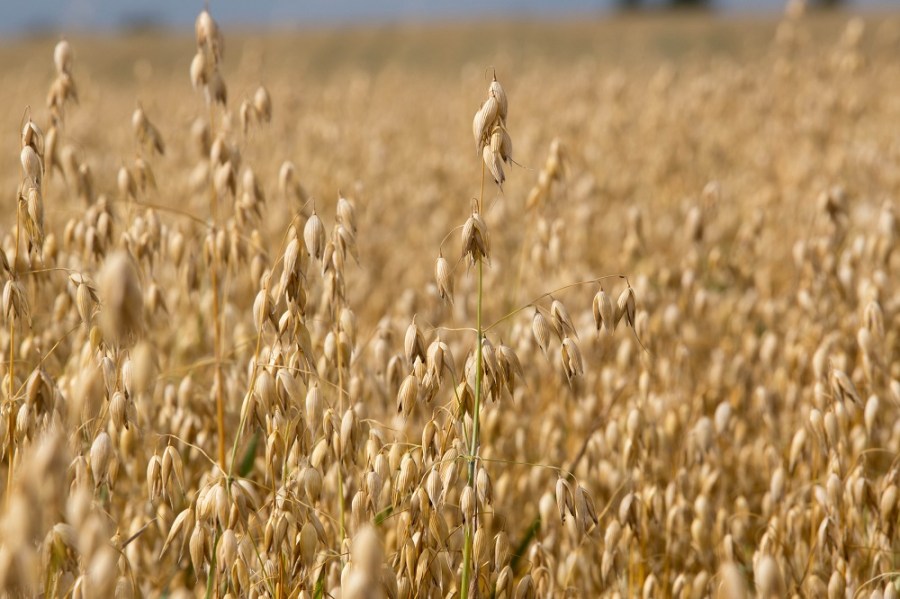While demand for oats has been growing for years, yields of even the best varieties have never stood out. But that could be changing – CPM reviews Senova’s new variety Maestro.
There have been high yielding varieties before but not with the high kernel content.
By Melanie Jenkins
The milling oat market is growing fast, and the three-crop rule has given farmers farmers an extra reason to consider including oats within the rotation. But yields have often disappointed – until now.
Meet Maestro – a variety which demonstrates all the good qualities of a milling oat, while delivering a high yield, attributes set to appeal to both millers and farmers. Maestro entered the AHDB Cereals and Oilseeds Recommended List last year as the highest yielding oat variety – at 105% of control it’s 3 percentage points higher than the second highest yielding competitor.
The high yields make it an exciting variety says Tom Yewbrey, of agent Senova. “It comes in 8 percentage points

Maestro comes in 8 percentage points higher than Mascani, the current market favourite, points out Tom Yewbury.
higher than Mascani, the current market favourite. Maestro offers very good kernel content, at 77.1%, and a specific weight of 52.1kg/hl, with the buying specification usually set at 50kg/hl. Agronomically it’s good against mildew and has reasonable standing strength.”
Good hullability
Tom Yewbrey says that more millers are focusing on hullability – the separation of the kernel from the husk. “Maestro has good hullability and is therefore a positive development for millers.”
However, there’s not a lot of information from the trial data so far, so Senova is planning to put more bulk in front of millers so there’s progression from this harvest onwards, he adds. “This year will be its first real year out on farm.”
Producing a variety that’s desirable to the farmer is important but it also has to offer something to the human consumption market so that farmers can sell it, says Tom Yewbrey. “The combination of high yields with good milling quality is what makes Maestro stand out. There have been high yielding varieties before but not with the high kernel content, so Maestro’s good for both farmers and millers.”
Simon Oxley of AHDB agrees the variety has a good kernel content. “Although its specific weight is lower than the other recommended varieties, which is to be expected with a higher yielding variety, it’s well above the minimum set for recommendation. It’s also relatively weaker strawed, so attention to detail is needed with a PGR programme.”
The screenings of Maestro should also be watched, compared with the other RL varieties, as it loses an average of 8.9% through a 2mm sieve, whereas Mascani only loses 1.4%. “Maestro has a score of 5 for mildew and 4 for crown rust, so a good fungicide programme is recommended.”
Farmers are most likely to be attracted to Maestro because of its higher yield, explains Simon Oxley. “Though the kernel content is similar to Mascani, the big difference will be the yield for growers, but then a lot will depend on the end users. If a farmer is growing it for milling quality, they need to make sure the end user is happy with it first.”
After breeding the winter oat Mascani, the Institute of Biological, Environmental and Rural Sciences (IBERS) has focused on adding to the good milling qualities it demonstrated, while increasing grain yield. Athole Marshall, principal investigator at IBERS, says they were also looking to improve the grain composition.
The soluble fibre (beta-glucan) content is an important component that helps to deliver the health benefits associated with eating oats. “At the same time, we were looking at the agronomic performance and trying to balance grain quality with maximising yield for the grower.”
Oats are a low input crop, requiring less fertiliser than other cereals, and are effective at taking N from the soil, explains Athole Marshall. “They can help to broaden a rotation and there’s evidence that they can be beneficial for the health of other crops in the rotation – they’re an effective break crop for take-all in wheat.” Oats also fit well into organic agriculture as the canopy smothers weeds, he adds.
As demand for human-consumption oats has increased, this has driven development, diversity and innovation, says Athole Marshall. “There’s certainly more effort going into breeding oat varieties that meet the requirements of the industry.”
Independent agronomist Antony Wade suggests that farmers looking to grow oats should be careful where they grow them as grassweeds can be an issue. “Consider the burden of blackgrass and ryegrass particularly as you’ll only want to grow oats somewhere that doesn’t have a real issue with these.” If grassweeds are an issue, then a pre-emergence spray would be necessary, he adds.

Grassweeds can be an issue with oats, advises Antony Wade.
In terms of drilling date, Antony Wade suggests oats can go in well into Oct, although reducing the seed rate is advisable to limit the risk of lodging. “As oats will tiller quite profusely, you can safely reduce the seed rate.”
Oats are fairly cheap to grow and have low N requirements of between 90-120kgN/ha, which is about half a typical wheat requirement, he points out. PGRs are important but products can have limited usage, he warns. “Trinexapac products can be applied at GS30-31 in combination with chlormequat but can be harsh on oats, while Canopy (prohexadione-calcium+ mepiquat chloride), a newer product, can be used up to GS39. In the spring, oats might not get going quickly, but will then suddenly spring into rapid stem extension making it difficult to time growth regulation.”
Diseases can generally be controlled quite easily, says Antony Wade. “Mildew can be a problem early on if the crop has a thick canopy – although of course it also depends on the spring weather. While crown rust is usually worst in the South West throughout the season due to the conducive wetter and warmer weather, in the rest of the country it’s normally a late summer disease when more humid conditions set in,” he explains.
“Unless you have to apply an early mildew spray, then an early stem extension fungicide, such as a strobilurin plus triazole co-formulation, should suffice.” SDHIs are another option, but less appealing for those trying to grow with lower cost inputs, he adds.
Fungicide spray
Antony Wade suggests a second fungicide spray that includes a strobilurin when panicles are half emerged, around mid to early June, which will reduce disease on the grain, keeping the sample bright and preserving the quality for milling.
It’s not yet clear if millers like Maestro, but as they use specific weight as the criteria for milling grading, anything to help this needs to be considered. “Traditionally growers would apply a single fungicide spray mid-season but a late spray will help to maintain specific weight as a late crown rust infection can be devastating.”
At the end of May, there were few unsold parcels of oats from harvest 2015, according to Robert Leachman, oat trader at Gleadell. “The 2015 market ended the season with sharply higher prices and the oat millers just about covered their requirements from an above average quality crop. The 2016 oat crop looks well and this has partly influenced the oat miller to play a waiting game on forward purchases.”
Shaun Jenkins, grain manager at European Oat Millers, confirms that the old crop market is very tight and winter plantings are down, so it could be another year with closely matched supply and demand.
“There’s a lot of demand coming from the export markets and demand in general is increasing,” he says. “There’s definitely room for more oats to be grown.”
It would also be nice to see a strong spring oat come forward, as this could encourage more farmers to grow spring oats to comply with the three-crop rule and tackle blackgrass issues, he adds.
However, Maestro is still an unknown quantity and European Oat Millers is yet to experience any commercially grown oats through the mill. “We have a 145t sample of Maestro coming in this year, so come the end of the year we’ll be better placed to comment.”
According to AHDB senior analyst Helen Plant, total oat usage by millers in the UK is expected to reach 530,000t in the 2015/16 period – a 6% increase on 2014/15. “This’ll be a new record and is 30% up on usage 10 years ago.”
In the same period, feed demand was estimated at 234,000t, making total demand 789,000t, while total supply equated to 799,000t. This tight balance is set to carry forward to the 2016 harvest, she adds. “Overall GB winter plantings look to be down year-on-year, meaning spring plantings are particularly important to the total area.”
The growth in demand has been driven by new product development as well as the health benefits associated with oats, such as combatting certain types of cholesterol. “Demand has grown domestically and for export, but the market is still relatively small compared to wheat and barley,” she says.
“If growers are interested in planting oats for harvest in 2017, it’s worth speaking to a merchant first as opportunities vary across the country.”
In Scotland, the oat market has been growing steadily for the past 10 years, according to Alan Meikle, managing director at Hamlyns Oats. “If you go back 20 years, the only oat food product was plain porridge and now there’s a huge range of porridge products available from pots to sachets,” he says.
“Going forward there’s a lot of development, as oats are being added to biscuits and cakes, either as a normal listed ingredient, or in the mix. The market’s all positive and there are most definitely increasing opportunities for more growers.”
High hopes for well tillered crop
Farming just over 600ha near Hemel Hempstead in Herts, Andy Hobbs currently has around 12ha of Maestro in the ground. He’d already grown Mascani and Gerald for European Oat Millers and decided to give Maestro a go on a suggestion from his grain merchant. “We’re just growing oats as a third crop but they’ve been reasonably profitable,” he says.
It was planted on 13 Oct using a Kuhn Espro drill into a gravel-based medium loam, at a very low seed rate of 120kg/ha. “This was recommended by our supplier (because it tillers so well) but normally we’d drill at 160-170kg/ha,” says Andy Hobbs. The crop established well and needed no inputs out of the ordinary, just 350kg/ha of nitrate fertiliser, he adds.
On 3 Dec the crop was sprayed for broadleaf weeds alongside a manganese dressing and then on 6 May it was sprayed for rust, mildew and broadleaf weeds, again with a manganese dressing.
Andy Hobbs says that if Maestro harvests well then he’ll possibly grow it again. “I’m hoping to get 7.4t/ha but I’m not sure if it’ll meet the target specification yet. Overall it established well at a low seed rate, tillered nicely and looks like it’ll do fine, but I don’t like to get my hopes up until it’s been combined.”
Spring drilled
Darren Maskell currently has about 20ha of Maestro in the ground just south of Bedford. Although it’s a winter oat, he planted it on 6 May as a spring oat with a conventional tine drill.
“It was too wet to get it in earlier and as a result two fields came up within a week, but the third, a wetter field, took about two weeks to emerge.” He applied around 247kg/ha of nitrate fertiliser in the last week of May.
Having previously grown Dalguise, Darren Maskell uses oats as a break crop and also grows wheat, oilseed rape and barley. “I hope the Maestro will do well, but the recent rains might cause a few issues,” he says.
Maestro at a glance
| UK yield (% treated control – 8.4t/ha) | 105.0 |
| Treated yields with PGR (8.5t/ha) | 104.8 |
| Kernel content | 77.1 |
| Specific weight (kg/hl) | 52.1 |
| Screenings % through 2.0mm | 8.9 |
| Resistance to lodging | [5] |
| Straw length (cm) | 109.2 |
| Disease | |
| Mildew | [5] |
| Crown rust | 3.7 |
Source: AHDB Cereals and Oilseeds Recommended List Winter Oats 2016/17; [] limited data




